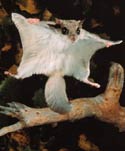|
Description: The Southern Flying Squirrel (Sciuridae:
Glaucomys volans) is very small squirrel.
Very silky coat grayish brown above, white below, with hairs all
white from tip to base.
Loose fold of skin between foreleg and hind-leg. Flattened
gray-brown tail. Large black
eyes. L 7 3/4–10 1/8"; T 3 1/8–4 3/4" ; H 7/8–1 1/4" ; Wt 1
1/2–3 1/8 oz.
Similar Species: Slightly larger Northern Flying Squirrel is a
richer brown, with abdominal
fur usually gray at base.
Breeding: The female usually mates in early spring with 2 to 7
young born after a gestation
of 41 days. Often a second litter is born during
August–September, usually by females that
do not breed in spring.
Habitat: Various deciduous forests such as beech, maple, oak,
hickory, and, in the South,
Live Oak.
Range: Eastern U.S. (except for northern New England and the
southern tip of Florida) east
of Minnesota, eastern Kansas, and eastern Texas.
Discussion: The flying squirrels are the only nocturnal tree
squirrels. Although it is active in
all seasons, the Southern Flying Squirrel may remain in its nest
in very cold weather and
will enter torpor in times of extreme cold or food scarcity. The
state of torpor is not as deep
as true hibernation, but the animal’s body temperature can drop
to 22°F (–6°C), and it may
take up to 40 minutes to wake. In winter, several individuals
may den together in one tree
hole, as their combined body heat brings up the den temperature;
as many as 50
individuals have been found in one nest in winter.
The flying squirrel glides through the air, up to 80 yards or
more, from the top of one tree
down to the trunk of another. It glides with its legs
outstretched and the fold of skin
between foreleg and hind-leg acting as a combination parachute
and sail. While gliding, it
can turn or change its angle of descent. Just before landing, it
drops its tail and lifts its
forelegs, slackening the flight skin, which then serves as an
air brake. It lands very lightly on all four feet, and scurries
around to the other side of the tree trunk, in case a predator
has followed its flight. Agile and extremely surefooted aloft,
it is relatively clumsy on the
ground.
RETURN TO TOP |

